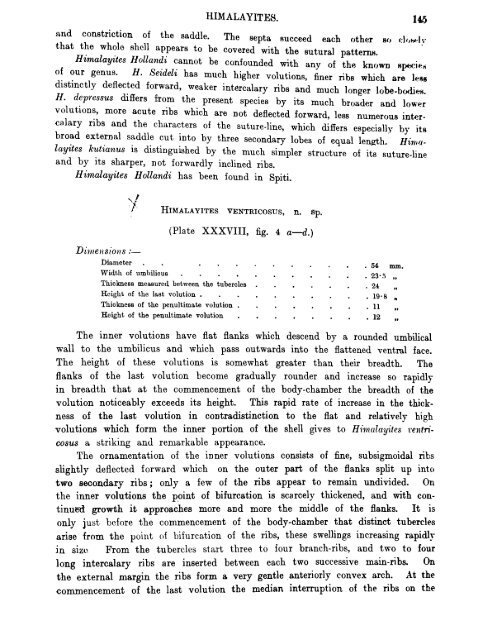Ser. XV. HIMALAYAN FOSSILS, Vol. IV. THE FAUNA OF THE SPITI ...
Ser. XV. HIMALAYAN FOSSILS, Vol. IV. THE FAUNA OF THE SPITI ...
Ser. XV. HIMALAYAN FOSSILS, Vol. IV. THE FAUNA OF THE SPITI ...
You also want an ePaper? Increase the reach of your titles
YUMPU automatically turns print PDFs into web optimized ePapers that Google loves.
HIMALAYITES. 137<br />
and constriction of the saddle. The septa succeed each other so cWlv<br />
that the whole shell appears to be covered with the sutural patterns.<br />
Himalayites Hollandi cannot be confounded with any of the known specie,<br />
of our genus. H. Seideli has much higher volutions, finer ribs which are lew<br />
distinctly deflected forward, weaker intercalary ribs and much longer lobe-bodies.<br />
H. depressus differs from the present species by its much broader and lower<br />
volutions, more acute ribs which are not deflected forward, less numerous intercalary<br />
ribs and the characters of the suture-line, which differs especially by its<br />
broad external saddle cut into by three secondary lobes of equal length. Himalayites<br />
kutianus is distinguished by the much simpler structure of its suture-line<br />
and by its sharper, not forwardly inclined ribs.<br />
Himalayites Hollandi has been found in Spiti.<br />
Dimensions :—<br />
/ HIMALAYITES VENTRICOSXJS, n. sp.<br />
(Plate XX<strong>XV</strong>III, fig. 4 a—d.)<br />
Diameter . . . .<br />
Width of umbilicus . . . .<br />
Thickness measured between the tubercles<br />
Height of the last volution .<br />
Thickness of the penultimate volution .<br />
Height of the penultimate volution<br />
. 54 mm.<br />
. 23-5 „<br />
• 24 „<br />
. 19-8 „<br />
• 11<br />
. 12 ..<br />
The inner volutions have flat flanks which descend by a rounded umbilical<br />
wall to the umbilicus and which pass outwards into the flattened ventral face.<br />
The height of these volutions is somewhat greater than their breadth. The<br />
flanks of the last volution become gradually rounder and increase so rapidly<br />
in breadth that at the commencement of the body-chamber the breadth of the<br />
volution noticeably exceeds its height. This rapid rate of increase in the thick-<br />
ness of the last volution in contradistinction to the flat and relatively high<br />
volutions which form the inner portion of the shell gives to Himalayites ventri-<br />
cosus a striking and remarkable appearance.<br />
The ornamentation of the inner volutions consists of fine, subsigmoidal ribs<br />
shghtly deflected forward which on the outer part of the flanks split up into<br />
two secondary ribs; only a few of the ribs appear to remain undivided. On<br />
the inner volutions the point of bifurcation is scarcely thickened, and with con-<br />
tinued growth it approaches more and more the middle of the flanks. It is<br />
only just before the commencement of the body-chamber that distinct tubercles<br />
arise from the point of bifurcation of the ribs, these swellings increasing rapidly<br />
in size From the tubercles start three to four branch-ribs, and two to four<br />
long intercalary ribs are inserted between each two successive main-ribs. On<br />
the external margin the ribs form a very gentle anteriorly convex arch. At the<br />
commencement of the last volution the median interruption of the ribs on the

















